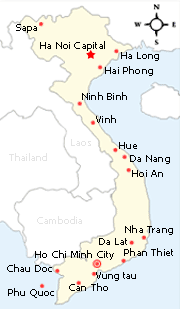|
Touch of ancient values A colleague told me, “Come to Hung Yen, I will take you where all your wishes will be satisfied.” Though not a superstitious person and having never prayed to God or Buddha, the radiant smile and keen face of my colleague aroused my curiosity and enticed me to make a trip to Hung Yen, a northern province endowed with many ancient historical and cultural relics, some of them recognized as national sites and many of them religious works.
A view of longan tree in front of Hien Pagoda in Pho Hien relic complex in Hung Yen province. Traditionally, each village has a communal house next to a century-old banyan tree and a big water well which is stamped deeply onto the minds of the locals from childhood and leaves a permanent stamp on the minds of expatriates as well. Looming behind the green bamboo ramparts are the communal houses, pagodas, temples and shrines. Even from a distance, the roof of the communal house can be seen among luxuriant green tree canopies. Huge ancient trees surround the house and their green leaves embellish the roofs, making the scenery more vivid. Most pagodas and temples are surrounded by banyans, fig trees and longan trees which all stay green year round. The Pho Hien relic complex, of which Mau Temple is a highlight, is an attraction and a mystery. Once stepping into the temple, travelers will be amazed by the huge seven-hundred-year-old tree which makes a domed gate for the temple. Different from other temples in the country that honor powerful Vietnamese women or Goddesses, Mau Temple is dedicated to worshipping Duong Quy Phi, a beauty queen in China’s ancient history. Legend has it that those who touch the palanquin which was once used to transport the queen will enjoy good health and good luck. Ban Nguyen Lake in front of the temple is also a nice place waiting for travelers’ footprints. Another attraction tourists should not miss is the huge longan tree, called Nhan To, in front of Hien Pagoda. Believed to be 300 years old, the tree is a sacred place for locals as they believe the tree brings Another relic of the Pho Hien relic complex worth visiting is Thien Hau Temple. This temple is dedicated to worshipping Lam Tuc Mac, a nautical goddess of China. The temple attracts pilgrims for annual festivals on the 23rd day of the third lunar month and the 9th day of the ninth lunar month (October 26 this year). Dong Do-Quang Hoi Temple is a former meeting place for traders, mainly from China, and worships three gods who are honored in a festival at the temple on the tenth day of the tenth lunar month. These two temples in Chinese architecture are historical records of commerce between Vietnam and China. Chuong (Bell) Pagoda is endowed with poetic scenery and boasts a stone bridge spanning a lotus pond and 18 statues of Arhats. Hung Yen Literature Temple holds a collection of ancient steles. Other relics of Pho Hien wear Vietnamese architecture, are decorated with the colors of folk belief and religion, and some are considered high in artistic value. Along with their architectural features, these relics have preserved utensils for religious offerings, palanquins, hammocks, horizontal lacquered boards and many pairs of wood panels with skillfully inscribed parallel sentences. More importantly, the relics of Pho Hien preserve their innate ancient beauty. With the wet rice civilization and culture, we catch the colors of bronze, stone, wood, tile and soil on each roof, door and path, which create a sense of immortality of each relic. With its role as a key link from the traffic artery of the Red River, Pho Hien was once a frontal port of Thang Long Citadel that opened to the sea, ranking second in importance to Hanoi, as goes an old Vietnamese saying. Today, Pho Hien residents are embracing the ambition to revive the glorious past. From Hanoi to Hung Yen, catch a bus from the Luong Yen bus station or from the Giap Bat bus station. VietNamNet/SGT Other news for Saturday 26 September, 2009
View all news for Saturday 26 September, 2009 on one page News for Friday 25 September, 2009 View all news for Friday 25 September, 2009 on one page Recent News
|










